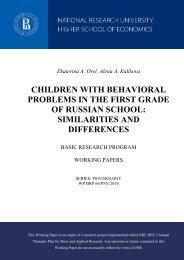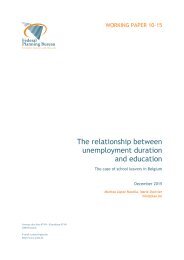Ten-Year Impacts of Burkina Faso’s BRIGHT Program
n?u=RePEc:mpr:mprres:2ecdd42bb503422b802ce20da2bf64b7&r=edu
n?u=RePEc:mpr:mprres:2ecdd42bb503422b802ce20da2bf64b7&r=edu
You also want an ePaper? Increase the reach of your titles
YUMPU automatically turns print PDFs into web optimized ePapers that Google loves.
IV: FINDINGS<br />
MATHEMATICA POLICY RESEARCH<br />
suggest that, at least for the older students, grade progression may be one <strong>of</strong> the primary<br />
mechanisms through which the <strong>BRIGHT</strong> program improves test scores.<br />
Figure IV.5. <strong>Ten</strong>-year impacts <strong>of</strong> the <strong>BRIGHT</strong> program on highest grade<br />
achieved and test scores, by age<br />
1.8<br />
0.6<br />
Estimated impacts on highest grade achieved<br />
1.5<br />
1.2<br />
0.9<br />
0.6<br />
0.3<br />
0<br />
-0.3<br />
0.5<br />
0.4<br />
0.3<br />
0.2<br />
0.1<br />
0<br />
-0.1<br />
5 6 7 8 9 10 11 12 13 14 15 16 17 18 19 20 21 22 23<br />
Age<br />
Estimated impacts on test scores<br />
Highest grade achieved<br />
Test scores<br />
Sources: Mathematica household survey (2015) and Mathematica school survey (2015).<br />
The next question is, then, why do <strong>BRIGHT</strong> schools cause students to progress farther than<br />
they otherwise would? In Table IV.6, we present estimated differences in measures <strong>of</strong> students’<br />
ages relative to their grades. As shown in the first row, only 37.2 percent <strong>of</strong> students in<br />
unselected villages can be considered to be the appropriate age for their grade, compared to<br />
percent in selected villages. 35 The next two rows show that the age inappropriateness is related to<br />
students being too old rather than too young for their grades. Students in unselected villages are,<br />
on average, 1.42 years “<strong>of</strong>f-grade;” students in selected villages are about one- quarter <strong>of</strong> a year<br />
closer to being the right age for their grade. One reason that students in selected villages are<br />
more likely to be on grade seems to be that they are more likely to start school on time and at a<br />
younger age—closer to the appropriate age for starting school (Table IV.6).<br />
35<br />
Students are expected to start 1st grade at age 7. So, students are classified as age appropriate if their age is within<br />
a year <strong>of</strong> their grade plus six years.<br />
46







